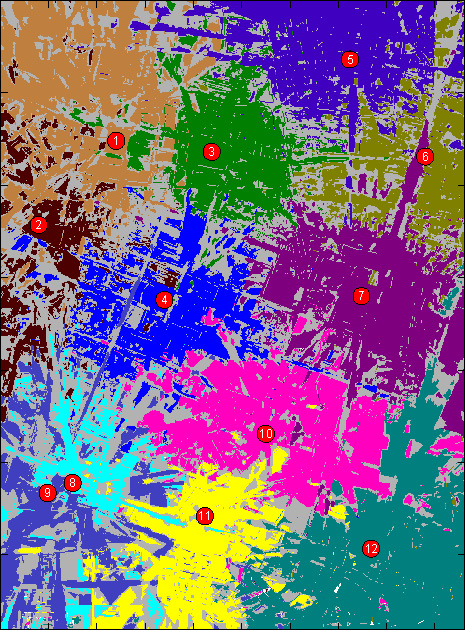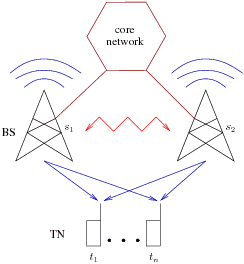Network Plannnig



The planning of wireless networks remains a crucial and complex problem in the future not least due to rising traffic demands. The problem consists of base station (BS) placement and traffic node (TN) assignment to BSs fulfilling the required bit rates. Moreover, two conflicting BSs (inter-cell interference) cannot be installed at the same time and each TN can only be served by at most one BS (hard handover). The power consumption of wireless networks is, not only from an ecological but also from a financial point of view, an important factor. Therefore, it should be considered for the planning of modern wireless networks. Signal propagation data is needed to determine the possible links between BSs and TNs which may be assessed by field strength prediction and wireless channel modeling.
An aspect which should be considered already in the planning of a wireless network are non-deterministic factors, e.g., user mobility, fluctuating bit rate requirements and channel conditions. To handle such uncertainties, robust optimization is a promising technique.
The Integer Linear Programs (ILPs) modeling the planning of (robust) wireless networks are in general computationally intractable. Therefore, advanced optimization methodologies are applied such as cutting planes to cut off non-integer solutions, branch-and-price to limit the number of variables, and (primal) heuristics to find good solutions in a short time.
The optimized radio network planning supports self-optimization of networks which is a key concept to adapt radio parameters of the network equipment in the operational phase autonomously, i.e., without human intervention and without the corresponding personnel expenses.
Related research topics and publications
Cell site planning for LTE networks
- A. Engels, M. Reyer, A. Steiger, R. Mathar, Min-Cut Based Partitioning for Urban LTE Cell Site Planning, Proceedings: The 10th IEEE Consumer Communications & Networking Conference CCNC 2013, Las Vegas, Nevada USA, January 2013.
Robust optimization for wireless network planning
- G. Claßen, A. M. C. A. Koster, A. Schmeink, A Robust Optimisation Model and Cutting Planes for the Planning of Energy-Efficient Wireless Networks, Computers and Operations Research, vol. 40, no. 1, pp. 80-90, January 2013.
- G. Claßen, A. M. C. A. Koster, A. Schmeink, Robust Planning of Green Wireless Networks, Proceedings: Proceedings of NetGCoop 2011, Paris;France, December 2011.
Conceptual extensions for radio network planning
- A. Engels, M. Neunerdt, R. Mathar, H. M. Abdullah, Acceptance as a Success Factor for Planning Wireless Network Infrastructure, Proceedings: International Symposium on Wireless Communication Systems 2011 (ISWCS'11), Aachen, Germany, November 2011.
Dimensioning of WiMAX multi-hop networks
- A. Engels, M. Reyer, R. Mathar, Profit-Oriented Combination of Multiple Objectives for Planning and Configuration of 4G Multi-Hop Relay Networks, Proceedings: 7th International Symposium on Wireless Communication Systems (IEEE ISWCS), York, United Kingdom, September 2010.
Cell site planning for UMTS networks
- R. Mathar, M. Schmeink, An integrated planning approach for cellular radio networks, In W. Jäger, H.J. Krebs (eds.): ser. MATHEMATICS, Key Technology for the Future., pp. 717-730, Publisher: Springer-Verlag, Berlin, 2003.
- R. Mathar, M. Schmeink, Integrated optimal cell site selection and frequency allocation for cellular radio networks, Telecommunication Systems, vol. 21, no. 2-4, pp. 339-347, 2002.
- U. Kohlhaas, R. Mathar, M. Schmeink, Optimality criteria for the cell site selection of CDMA cellular networks, In ser. Modeling and Simulation Environment for Satellite and Terrestrial Communication Networks, Proceedings of the European COST Telecommunications Symposium, pp. 161-173, Publisher: Kluwer Academic Publishers, Boston, 2001.
- R. Mathar, M. Schmeink, Optimal base station positioning and channel assignment for 3G mobile networks by integer programming, Annals of Operations Research, vol. 107, pp. 225-236, 2001.
Cell site planning for GSM networks
- R. Mathar, M. Schmeink, Optimization Models for GSM Radio Network Planning, Journal of Mobile Network Design and Innovation 2005, vol. 1, no. 1, pp. 70-75, 2005.
- R. Mathar, M. Schmeink, Integrated optimal cell site selection and frequency allocation for cellular radio networks, Telecommunication Systems, vol. 21, no. 2-4, pp. 339-347, 2002.
- R. Mathar, M. Schmeink, Optimal base station positioning and channel assignment for 3G mobile networks by integer programming, Annals of Operations Research, vol. 107, pp. 225-236, 2001.
Related projects
- Robust Optimization Methodologies for Wireless Network Planning is a joint project with Arie Koster from Lehr- und Forschungsgebiet Diskrete Optimierung, RWTH Aachen.
-
HUMIC: Akzeptanzbewertung als integraler Bestandteil von Entwicklung und Ausbau komplexer technischer Syteme. Am Beispiel Mobilfunk.
(April 2009 - )
Research Project within the Project House HumTec, funded by the DFG.
- Kanalmodelle für mobile Kommunikationsnetze der vierten Generation und deren Umsetzung in einer virtuellen Testumgebung
(July 2009 - June 2010)
Joint research project with Qosmotec Software Solutions GmbH, Aachen.
Partly funded by the BMWi \ AIF within ZIM-KOOP
Gefördert vom Bundesministerium für Wirtschaft und Technologie aufgrund eines Beschlusses des Deutschen Bundestages.
-
Self calibrating field strength prediction for WiMAX networks
(September 2007 - August 2008)
Joint research project with TEDSoft GmbH, Bonn.
Partly funded by the BMWA \ AIF within PROINNO II
- Optimization of broadband networks based on WiMAX- and DSL-technology (February
2007 - February 2008)
Joint research project with DBD Deutsche Breitband Dienste GmbH, Heidelberg.
- Modeling, planning, and optimization of CDMA cellular radio networks
(July 2000 - June 2002)
Funded by the European Commission as part of the Marie-Curie program.
- An integrated tool for planning cellular radio networks, mathematical
modeling and system optimization (Oct. 1997 - Sept. 2000)
Funded by the BMBF
Related student work
- Student research project Entwicklung und Umsetzung von Heuristiken zur Planung und Optimierung von Multihop-fähigen Mobilfunknetzen der vierten Generation
- Diploma Thesis Optimierung von WiMAX-Netzen mit Relaisstationen
Contact
For further information contact Michael Reyer.
***
Aktuelle Informationen gemäß Art. 13 DS-GVO:
Datenschutzhinweis ***
Impressum ***

